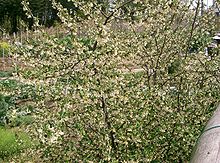Elaeagnus_multiflora
Elaeagnus multiflora
Species of flowering plant
Elaeagnus multiflora, the cherry elaeagnus,[1] cherry silverberry,[2] goumi, gumi, or natsugumi, is a species of Elaeagnus native to China, Korea, and Japan.
This article includes a list of general references, but it lacks sufficient corresponding inline citations. (February 2013) |
Elaeagnus multiflora is a deciduous or semi-evergreen shrub or small tree growing to 2–8 m (6 ft 7 in – 26 ft 3 in) tall, with a trunk up to 30 cm (12 in) diameter with dark brown bark. The shoots are densely covered in minute red-brown scales. The leaves are ovate to elliptic, 3–10 cm (1.2–3.9 in) long and 2–5 cm (0.79–1.97 in) broad, green above, and silvery to orange-brown below with dense small scales.
The flowers are solitary or in pairs in the leaf axils, fragrant, with a four-lobed pale yellowish-white corolla 1.5 cm (0.59 in) long; flowering is in mid-spring.


The fruit is a round to oval drupe 1 cm (0.39 in) long, silvery-scaled orange, ripening red dotted with silver or brown, pendulous on a 2–3 cm (0.79–1.18 in) peduncle. When ripe in mid- to late summer, the fruit is juicy and edible, with a sweet but astringent taste somewhat similar to that of rhubarb. The skin of the fruit is thin and fragile, making it difficult to transport, thus reducing its viability as a food crop.
As with other species in the genus Elaeagnus, E. multiflora plants are actinorhizal, growing in symbiosis with the bacterium Frankia in the soil. These bacteria fix atmospheric nitrogen, making it available in usable form for the host plant, and indirectly for other nearby plants. This feature allows the plant to grow in poorer soils than it could otherwise.
